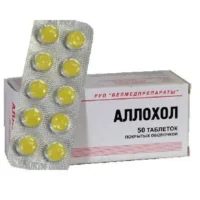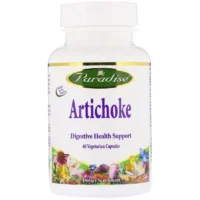Description
Artichol (Artichoke Dry Extract) Coated Tablets 0.2 g. №30
Ingredients
Each coated tablet contains 0.2 g of artichoke dry extract.
Mechanism of Action
The active compounds in artichoke extract, such as cynarin and chlorogenic acid, exhibit antioxidant and anti-inflammatory properties. These components contribute to the hepatoprotective and cholesterol-lowering effects of artichoke extract.
Pharmacological Properties
Artichoke extract aids in liver function, promotes bile production, and may help reduce cholesterol levels. It also supports digestive health due to its antioxidant and anti-inflammatory properties.
Indications for Use
Artichol tablets are indicated for liver support, improvement of digestion, and management of cholesterol levels. They may also aid in maintaining healthy blood sugar levels.
Contraindications
Do not use Artichol tablets if you are allergic to artichokes or any of the ingredients. Consult a healthcare professional before use if pregnant, nursing, or taking other medications.
Side Effects
Common side effects of Artichol tablets may include gastrointestinal discomfort, allergic reactions in individuals sensitive to artichokes, and rare cases of mild dizziness. Discontinue use if any adverse reactions occur.
Usage Instructions
Take one tablet three times a day with water before meals. Swallow the tablets whole; do not chew or crush them. Follow the recommended dosage and consult a healthcare provider for prolonged use.
Benefits Compared to Analogues
Artichol tablets offer a specialized coating process for optimal absorption and effectiveness. The high-quality artichoke extract is standardized to contain key active compounds, providing reliable and consistent health benefits.
Suitable Patient Groups
Artichol tablets are suitable for adult patients seeking liver support, improved digestion, and cholesterol management. Consult a healthcare provider for appropriate use in children, elderly individuals, and patients with specific health conditions.
Storage and Shelf Life
Store Artichol tablets in a cool, dry place away from direct sunlight. Keep the packaging tightly closed to protect from moisture. Check the expiration date on the packaging and do not use the tablets beyond the specified shelf life.
Packaging Description
Artichol tablets are packaged in a container with 30 coated tablets. The packaging is designed to maintain the quality and integrity of the tablets, ensuring their potency and efficacy until the expiration date.
Clinical Evidence and Proven Effectiveness
Artichoke extract has been studied for its hepatoprotective effects, aiding in liver function and promoting bile production. Research suggests that artichoke extract may help reduce cholesterol levels and support digestive health. A study published in the “Journal of Pharmacology” demonstrated the positive impact of artichoke extract on lipid metabolism.
Clinical studies have shown that artichoke extract can help improve liver enzyme levels and reduce symptoms of dyspepsia. A randomized controlled trial published in the “Journal of Herbal Pharmacotherapy” demonstrated the efficacy of artichoke extract in reducing symptoms of irritable bowel syndrome.





